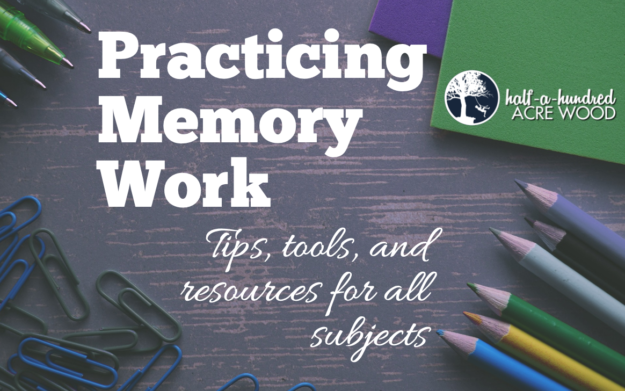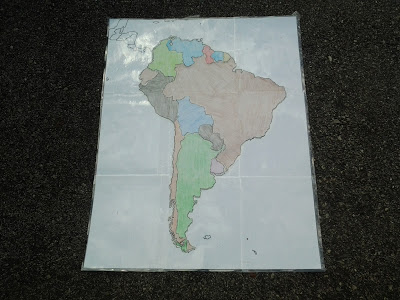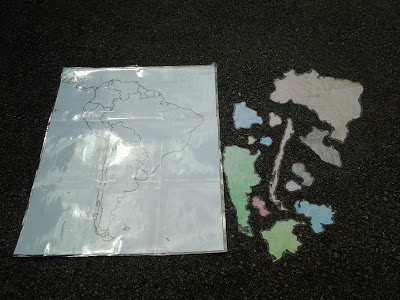
Our family simplifies our memory work practice because we like to spend more time enjoying our learning endeavors through projects and games. If we spent two hours per day on memory work practice, we would not be able to do all the other things we like and need to do.
So… we usually keep our memory work practice to less than 30 minutes. If I stretched out our memory work any longer, I’m not sure my children would like it as much.
Our family has a really easy, UNcreative way that we practice our memory work. We listen to songs and use hand motions (or practice our best Kung Fu moves) while singing. We listen to memory work songs over and over and over again – in the car and in the house. I quiz them randomly out loud. They are mainly auditory learners, so that works well for them!
Classical tutors provide a model of practicing memory work using a whiteboard with the idea that if we were marooned on an island without our color printers, laminators, tri-fold boards, or MP3 players, we could still teach our children by writing in the sand. So memory work practice doesn’t need to be any more complicated than that.
But what about children who do not know how to read and write? We (and they) can draw pictures. Most recognize their letters. They enjoy jumping around and chanting. And so… we can still use a stick in the sand.
But for those who would like ideas beyond the stick in the sand, that’s perfectly fine because we want our children to learn through playing! We want them to have fun in learning because – when it is fun – they will develop a deeper love of learning. With that, here’s a list of various ways to practice memory work, whether you’re memorizing Scripture, poetry, speeches, or facts.
Memory Work Practice Methods:
- Flashcards
- Dry Erase – erase a word or two each time you repeat the sentence/fact: This works for ALL subjects!
- Chant
- Charts
- Props/Object Lessons
- Sing
- Drill Sheets
- Draw/Trace/Copywork
- Use rhythm – clapping, stomping
- Activities – throw ball to each other while reciting, skip, hop, etc.
- Printed Visuals
- Hand motions
- Acrostics
- Follow the leader and repeat after me (student led or parent led).
- Act out or use puppets
- Games. Check out these Memory Work Review Games.
- Use different voices (say it in a “mouse” voice or a “cowboy” voice) Download review game dice here, which has voice play and action ideas to use during recitations. (Just ignore the “current week” dice. That was something we used personally at one time to ensure we were reviewing the prior six week’s material.)
Math
- Multiplication Fact Songs. We much prefer memorizing math facts rather than focusing so much on skip counting.
- Circle-and-Write Skip Counting Charts (circle the numbers)
- Write out skip counting numbers on construction paper and have students hop to the correct number in the correct order.
- Lay out the construction number sheets and give them a flyswatter to swat them in the correct order.
- Multiplication Drills and Multiplication Wheels
- Multiplication Tables (like this one for 9s)
- Copywork – on a blank sheet of paper or whiteboard
- Flashcards or Skip Counters
- Card Games (flip two cards and multiply)
- I Have… Who Has Multiplication
- Sing song while doing “aerobics” – jumping, skipping, jumping jacks
- Use puppets to chant the multiplication facts
- Visit our math resources for other ways to practice skip counting and multiplication facts, such as File Folder Games
Timeline
- Sing song while using flipcards.
- Timeline Thumbnails.
- Sing song and do timeline motions.
- Hide timeline cards in a room. Students find them and place in order.
- Mix up the timeline cards and have students place in order.
- For young children, lay out timeline cards on the floor and let them swat them with a flyswatter in the correct order.
- Keep a Timeline Notebook.
History
- Sing songs and use hand motions.
- Use printed visuals: Cut up pictures or sentences to put in order.
- Act out the history sentence.
- Copywork and/or Illustration.
Latin
- Charts (Declension Games, Conjugation Games)
- Visual Cues (Declension Cues, Keeping Verb Tenses Straight)
- Dry erase Board
- Songs and movements
- Games (See John 1 Vocabulary Games)
- Copywork (See John 1 in Latin.)
- Write declensions using strings of play-doh, or raisins on peanut-buttered bread, or icing on cookies…
English Grammar
- Copywork
- Prepositions Video with Motions
- Chant/Sing
- Worksheets and activities listed on English Grammar Post.
Geography
- Trace and Draw using maps. (See our Printable Atlas and Tracing Plan.)
- Use continental blobs to practice drawing continents using a blank sheet of paper. (See our Blob Map Printables and/or How to Draw the World Free-Hand.)
- Use geography songs for memorizing the countries of the world.
- Use visual cues such as those provided in Trick Geography.
- Show me: “Show me where ____ is on the map.”
- Tell me: “Tell me what this is.” [Parent points to a location on the map.]
- Seterra provides great printables and online quizzes for countries and physical features of the world.
- Print out huge MegaMaps from National Geographic to post on a wall and color in as you study each country.
- Print two Geography MegaMaps from YourChildLearns. Laminate or use Contact paper and use them to match up countries to continent.

This poster-sized puzzle was a big hit at GeoDrawing Camp. We even used it in our performance. What’s more, our oldest now knows not only the country locations but can recognize the shape of the country when it’s off by itself. It was worth the time I spent putting it together! This one was printed 3×3.
Science
- Mnemonics/Acrostics
- Sing, hand motions, or props
- Chants
- Dry erase – erase a word each time after reciting.
- Copywork and illustration
- Printed visuals or props
- Flashcards
- Make playdoh, clay, or food models
- An example of using charts and mnemonics for Classification
- Check our list of links for activities
Bible
- Visual Cues – Learn the Ten Commandments Video
- Rhymes – Memorize Ten Commandments Video
- Copywork – See Ten Commandments and John 1:1-7.
- Ephesians 6 Resources.
- More Bible Resources.
- Singing (We’ve used the MegaVerses song videos to memorize Exodus 20:1-17, Ephesians 6:1-20, and John 1:1-7.)
- File Folder Games
Fine Arts
- 5 Elements of Shape Practice
- Mirror Image Practice. Also visit this website for other mirror image practice sheets.
- Visit this webpage for step-by-step drawing practice pages.
- Visit Drawing Post for Fine Arts lesson plans.
- Visit Tin Whistle Post for lesson ideas
- Visit Great Artists Posts for ideas
- Visit Orchestra & Composers for ideas
Science Projects
- Review Scientific Method & experiment or project conducted in class (if you are in a classical homeschool tutorial)
- Sing the scientific method to “Mary Had a Little Lamb.” The scientific method is: Question, Research, Hypothesis, Experiment, Analysis, Conclusion.
- Check out our Scientific Method printables – posters, labsheets, and bookmarks.
- Visit our Science List of Links.
Presentations
- Visit our post on Presentation Prep, Skills, and Ideas!
- Some skills to practice (an focus on one each week): eye contact, project voice, enunciate clearly, use inflection and expression, standing still, using visuals appropriately, involving the audience, good posture, time management, pace, interesting content, watch filler words (like “umm….” and “and”), attention grabber, final clincher
- Children who are unable to read and write can still make notecards by drawing pictures to remind them of their main points. This worked very well for my kindergartner last year!
There you have it: lots of ideas to mix it up and make it fun. For us, singing songs, using a tri-fold board, and being silly just comes naturally. We throw in some extra drills – especially for math and Latin – but memory work practice is so simple for us as it stands now that I would never want to make it stressful by over-complicating it. If you’re still not sure how to handle memory work, just hop down to the comments and let us know!

